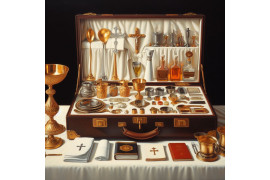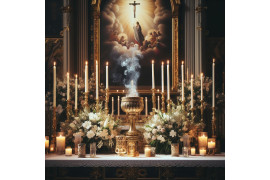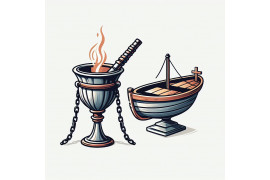The cruets used in Catholic Mass are essential vessels that hold water and wine during the liturgy. These vessels symbolize the offerings of the faithful and their active participation in the Eucharist, playing a crucial role in the sacrament of Holy Communion. The use of cruets represents the sacredness and reverence of the Catholic Mass, emphasizing the significance of these rituals within the faith.
During Mass, water is poured into one cruet, which is then mixed with wine in a chalice to prepare for consecration. This mixture symbolizes Christ's humanity and divinity coming together. The other cruet contains wine, which will be transformed into the Blood of Christ during the consecration.
The presence of these cruets highlights the importance of proper preparation and attention to detail in celebrating Mass. They serve as tangible reminders of the sacredness and solemnity of this religious ceremony.
Types and variations of cruets used
The cruets used in Catholic Mass come in various types and variations. These vessels hold the water and wine that are essential elements of the liturgy. Let's explore the different types and variations of cruets commonly used.
Common types include glass, crystal, or metal materials.
Cruets are typically made from glass, crystal, or metal materials. Glass cruets are popular due to their transparency, allowing the contents to be easily seen. Crystal cruets add an elegant touch with their sparkling appearance. Metal cruets, such as silver or pewter, can provide a more traditional or ornate look.
Different sizes available for holding varying amounts of water and wine.
Cruets come in different sizes to accommodate varying amounts of water and wine needed during Mass. Some may hold larger quantities for use during sacraments like baptisms or weddings, while others are smaller for regular liturgical use. The size of the cruets depends on the specific requirements of each church or parish.
Some cruets have decorative designs or religious symbols engraved on them.
Many cruets feature decorative designs or religious symbols engraved on their surfaces. These embellishments can include crosses, chalices, doves, grapes, wheat stalks - all rich with symbolic meaning in Catholicism. The intricate engravings add beauty and reverence to the vessels used in worship.
Variations can also include different shapes, such as traditional or modern styles.
In addition to material and design variations, cruets can also differ in shape. Some adhere to traditional forms with rounded bodies and narrow necks resembling ancient amphorae. Others embrace modern aesthetics with sleek lines and minimalist designs. The choice of shape often reflects the personal preferences and style choices of individual churches or clergy members.
Importance of proper preparation and handling
Careful Washing, Drying, and Filling
In the Catholic Mass, cruets play a significant role in the preparation and serving of sacred substances. These vessels, typically made of precious metals or other suitable materials, should be carefully washed, dried, and filled before each Mass. This attention to detail ensures that they are clean and ready for use during the celebration.
Cleanliness and Respect for Sacred Substances
Proper handling of cruets is essential to maintain cleanliness and show respect for the sacred substances they contain. During Mass, these vessels hold the wine and water that will be transformed into the Blood of Christ. As such, it is crucial to handle them with reverence and care.
Avoiding Spillage or Contamination
To avoid spillage or contamination during use, great care must be taken when handling cruets. The person responsible for pouring the wine or water into the chalice needs to pour it slowly and steadily to prevent any mishaps. Ensuring that the lids are securely fastened can help prevent any accidental spills.
Regular Maintenance for Longevity
Cruets require regular maintenance to ensure their longevity and functionality. After each use, they should be thoroughly cleaned with warm water and a mild detergent. It is important to dry them completely before storing them away to prevent any damage or corrosion.
Preserving Sacred Objects
The proper preparation and handling of cruets contribute to preserving these sacred objects for future celebrations. By following general instructions on how to care for them, individuals can ensure that these vessels remain in good condition over time.
Exploring the role of cruets in alms collection
Cruets, those small vessels often seen on the altar during Catholic Mass, have a significant role beyond holding water and wine. In some instances, they are also used to collect monetary offerings from parishioners as a form of alms. This practice holds great importance within the Catholic community and contributes to charitable works that benefit those in need.
The act of collecting alms during Mass symbolizes generosity and support for individuals or organizations requiring assistance. It serves as a reminder to the faithful about their responsibility to help others who may be less fortunate. By contributing to the collection plate, parishioners actively participate in acts of charity and demonstrate their commitment to living out the teachings of Christ.
Alms Collected Contribute to Charitable Works within the Community
The funds collected through alms during Mass play a crucial role in supporting various charitable initiatives within the local community. These contributions enable churches and religious organizations to provide financial aid, food, shelter, education, healthcare, and other essential services to those who are vulnerable or facing hardships.
By pooling together these monetary offerings from parishioners, churches can make a significant impact on improving people's lives. The funds may be directed towards programs that assist individuals experiencing homelessness, families struggling with poverty, victims of natural disasters or emergencies, or even initiatives focused on promoting social justice and equality.
Cruets: Vessels for Water, Wine, and Acts of Charity
Cruets serve as more than just containers for water and wine used during Mass; they represent vessels for acts of charity. They embody the spirit of giving and remind worshipers of their duty to support others in need. Just as water and wine are poured into these vessels before being offered at the altar, so too are acts of kindness poured forth through generous donations.
The presence of cruets on the altar serves as a visual reminder that extends beyond the physical act of collecting alms. It prompts individuals to reflect on their own blessings and encourages them to share their resources with others. The hymns sung during the collection further emphasize the importance of giving and inspire a sense of unity among the congregation.
Understanding the symbolism of water and wine in cruets
Water and wine play significant roles in the Catholic Mass, and the vessels used to hold them, known as cruets, carry deep symbolism. Let's explore the meaning behind these elements and how they are incorporated into liturgical celebrations.
Water Represents Purification, Cleansing, Baptismal Grace, and Spiritual Rebirth
In Catholic theology, water holds great significance. It symbolizes purification, cleansing, and renewal. Just as physical water cleanses our bodies, the use of holy water during Mass represents spiritual purification. Water is also closely associated with baptismal grace—the sacrament through which a person becomes part of the Christian community. Through baptism, individuals are cleansed of original sin and receive new life in Christ.
Wine Symbolizes Christ's Blood Shed on Calvary, Representing Salvation
Wine holds a special place in Catholic tradition as it symbolizes the blood of Christ shed on Calvary for the salvation of humanity. During the Last Supper, Jesus shared bread and wine with his disciples, instructing them to do so in remembrance of him. This act became the foundation for the Eucharist—the central sacrament of Catholic worship—where bread and wine are consecrated to become the body and blood of Christ.
The Combination Signifies Both Humanity (Water) and Divinity (Wine) United in Jesus
The combination of water and wine in cruets serves as a powerful representation of both humanity and divinity united in Jesus Christ. Just as water signifies our human nature—our need for cleansing and rebirth—wine represents Christ's divine nature. The mingling of these two substances during Mass signifies that Jesus is both fully human and fully divine—a profound mystery at the heart of Christian faith.
Cruet Usage Highlights These Symbolic Elements During Liturgical Celebrations
During Mass or other liturgical celebrations, priests or deacons use cruets to hold the water and wine that will be consecrated. The water is typically poured into a smaller cruet, while the wine is placed in a larger one. These sacred vessels are carefully handled and treated with reverence due to their symbolic significance.
When it comes time for the Offertory—the part of the Mass where bread and wine are brought forward—cruets play a vital role. The priest or deacon pours a small amount of water into the chalice containing the wine, symbolizing the union of humanity and divinity in Jesus Christ. This act reminds us that through Christ's sacrifice, we are invited to share in his divine life.
In addition to their symbolic importance, cruets also serve practical purposes during Mass. They ensure that an adequate amount of water and wine is available for consecration, allowing for smooth and uninterrupted worship.
Affordable communion supplies for Mass
Options for Every Budget
Catholic churches often require specific items and supplies. One such item is the cruets, which are used to hold the wine and water during the Eucharistic celebration. But what if your parish is on a tight budget? Don't worry! There are affordable options available online or at religious supply stores.
Inexpensive Glass or Plastic Cruets
For smaller parishes or those looking for more cost-effective solutions, inexpensive glass or plastic cruets can be a great choice. These cruets serve the same purpose as their more expensive counterparts but come at a fraction of the cost. They are durable, easy to clean, and can be reused for multiple Masses.
Here are some key points about these affordable cruets:
-
Glass Cruets: Made from sturdy glass material that is resistant to breaking or chipping.
-
Plastic Cruets: Lightweight and shatterproof alternative that offers convenience and durability.
-
Cost-effective: Available at lower price points compared to high-end crystal or metal options.
-
Easy to Clean: Both glass and plastic cruets can be easily washed by hand using mild soap and warm water.
Bulk Purchasing Discounts
If your church has a larger congregation, you may consider buying communion supplies in bulk. Many religious supply stores offer discounts when purchasing items like cruets in larger quantities. This allows you to save money while ensuring that you have an ample supply of necessary items for your Masses.
Here are some advantages of bulk purchasing:
-
Cost Savings: Buying in bulk often results in significant savings per unit compared to individual purchases.
-
Convenient Stocking: Having a surplus of communion supplies ensures that you never run out during important celebrations.
-
Reduced Shipping Costs: Some suppliers may offer free or discounted shipping when ordering in bulk quantities.
Budget-Friendly Alternatives without Compromising Quality
It's important to find a balance between cost and quality. While affordable options may not have the same level of craftsmanship as more expensive ones, they can still serve their purpose effectively.
Consider these factors when choosing budget-friendly communion supplies:
-
Material: Look for durable materials like glass or plastic that are less likely to break or deteriorate over time.
-
Functionality: Ensure that the cruets you choose are practical and easy to use during Mass.
-
Aesthetics: While appearance is not the most crucial aspect, finding cruets that align with your church's aesthetic can be a bonus.
Remember, the focus should always be on the sacredness of the Eucharist rather than the material possessions used during Mass. By prioritizing affordability without compromising quality, you can ensure that your parish has all the necessary supplies for a meaningful celebration.
The enduring importance of cruets
In the Catholic Mass, cruets play a significant role in the preparation and celebration of the Eucharist. As we have explored in this blog post, these vessels are used to hold the water and wine that are essential elements of the sacrament. The careful selection and handling of cruets reflect the reverence and respect given to this sacred ritual.
To ensure a seamless experience during Mass, it is crucial to invest in high-quality communion supplies, including cruets. Affordable options are available that meet the necessary standards without compromising on craftsmanship or symbolism. By choosing reliable suppliers who understand the significance of each item used in the Mass, you can contribute to creating a meaningful worship environment for both priests and congregants.
FAQs
What materials are commonly used for making cruets?
Cruets are typically made from glass or metal, with glass being the most common material due to its transparency and ease of cleaning. Metal options often include silver or stainless steel, which provide durability and an elegant appearance.
Can I use any type of water or wine for the cruets?
It is recommended to use clean, pure water for liturgical purposes. As for wine, only natural grape wine should be used during Mass as it symbolizes Christ's blood. It is important to follow guidelines set by your diocese regarding specific requirements for water and wine used in cruets.
How should I handle and care for my cruets?
Cruets should be handled with care to avoid breakage or spillage. After each use, they should be thoroughly cleaned using warm water and mild soap. Regular maintenance will help preserve their integrity over time.
Are there different sizes of cruets available?
Yes, there are various sizes available depending on personal preference and practicality. Common sizes range from 4 ounces (118 ml) up to 16 ounces (473 ml). Consider factors such as altar space and the number of communicants when selecting the appropriate size.
Where can I purchase cruets for Catholic Mass?
Cruets can be purchased from reputable religious supply stores, online retailers specializing in liturgical items, or directly from your local parish. Ensure that the supplier you choose adheres to the necessary standards and provides high-quality products suitable for use in the Catholic Mass.



